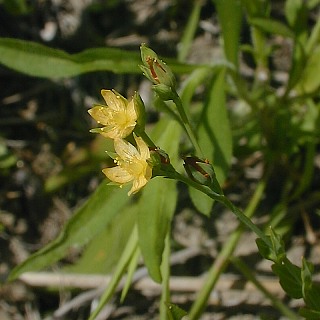Difference between revisions of "Hypericum gymnanthum"
Emmazeitler (talk | contribs) (→Phenology) |
|||
| Line 49: | Line 49: | ||
<!--==Diseases and parasites==--> | <!--==Diseases and parasites==--> | ||
| − | ==Conservation and | + | ==Conservation, cultivation, and restoration== |
''H. gymnanthum'' is listed as endangered by the Maryland Department of Natural Resources, Natural Heritage Program and by the Ohio Department of Natural Resources, Division of Natural Areas and Preserves. It is also listed as extirpated by the Pennsylvania Department of Conservation and Natural Resources.<ref name= "USDA"> [https://plants.usda.gov/core/profile?symbol=CEAM USDA Plant Database]</ref> | ''H. gymnanthum'' is listed as endangered by the Maryland Department of Natural Resources, Natural Heritage Program and by the Ohio Department of Natural Resources, Division of Natural Areas and Preserves. It is also listed as extirpated by the Pennsylvania Department of Conservation and Natural Resources.<ref name= "USDA"> [https://plants.usda.gov/core/profile?symbol=CEAM USDA Plant Database]</ref> | ||
| − | == | + | ==Cultural use== |
==Photo Gallery== | ==Photo Gallery== | ||
<gallery widths=180px> | <gallery widths=180px> | ||
</gallery> | </gallery> | ||
==References and notes== | ==References and notes== | ||
Revision as of 16:42, 8 June 2021
Common Names: Clasping-leaf St. John's-wort [1]
| Hypericum gymnanthum | |
|---|---|

| |
| Photo from Illinois Wildflowers Plant Database | |
| Scientific classification | |
| Kingdom: | Plantae |
| Division: | Magnoliophyta - Flowering plants |
| Class: | Magnoliopsida - Dicots |
| Order: | Theales |
| Family: | Clusiaceae |
| Genus: | Hypericum |
| Species: | H. gymnanthum |
| Binomial name | |
| Hypericum gymnanthum L | |

| |
| Natural range of Hypericum gymnanthum from USDA NRCS Plants Database. | |
Contents
Taxonomic Notes
Synonyms: none.[2]
Varieties: none.[2]
Description
H. gymnanthum is a perennial forb/herb of the Clusiaceae family that is native to North America. [1] It reaches heights between 1 to 3 feet with cyme inflorescences containing 5 petals on each flower.[3]
"Lower leaves much smaller than the medial and upper ones; medial and upper leaves firm, ovate-triangular, usually clasping, pointed apically, 5-7-nerved, about 1.5 cm long and 1 cm wide at the base, finely punctate-dotted, usually on both surfaces. Sepals 5, 3-5 mm long, lanceolate, long-acute to acuminate apically, oil tubes showing as lines. Petals 5, yellow, 3-6 mm long. Stamens few. Styles 3, 0.5-1 mm long. Capsules ellipsoid-conical, 3-4 mm long, equaling or slightly exceeding the calyx. Seeds buffish, minute, oblong, about 0.3 mm long, very faintly reticulate."[4]
Distribution
H. gymnanthum is found throughout the eastern United States in several states: Florida, Georgia, South Carolina, North Carolina, Alabama, Mississippi, Louisiana, Texas, Arkansas, Tennessee, Virginia, Missouri, Kansas, Illinois, Indiana, Ohio, West Virginia, Pennsylvania, Maryland, New Jersey, and New York.[1] It was added to the Kentucky flora in 2013, and is also disjunct in Guatemala, which might be an introduced population.[5]
Ecology
Habitat
Common habitats include pine savannas, wet pine flatwoods, sinkhole ponds in Virginia, and other wet habitats.[5] Wet habitats include bogs, muddy or sandy shores, swales, glades, and cypress depressions in flatwoods.[6] Specimens have been collected from habitats including the edge of small ponds in longleaf pine woodland, wet roadside depression, moist loamy sands, the edge of wet savannas, and pine canopy forests. [7] Within the southeastern coastal plain, H. gymnanthum is listed by the USDA Natural Resources Conservation Service as a facultative wetland species that most often can be found in wetland habitats but can also occasionally be found in non-wetland habitats.[1]
Associated species include Phyla sp., Cyperus sp., Rhynchospora marliniana, Habenaria nivea, Aristida beyrichiana, Ilex glabra, Quercus elliottii, and others.[7]
Phenology
Generally, H. gymnanthum flowers from June until September.[5] It has been observed flowering in May, July, and August.[8]
Pollination
While it usually reproduces asexually or through self-fertilization, it is thought to be possibly beetle-pollinated as well.[6]
Conservation, cultivation, and restoration
H. gymnanthum is listed as endangered by the Maryland Department of Natural Resources, Natural Heritage Program and by the Ohio Department of Natural Resources, Division of Natural Areas and Preserves. It is also listed as extirpated by the Pennsylvania Department of Conservation and Natural Resources.[1]
Cultural use
Photo Gallery
References and notes
- ↑ 1.0 1.1 1.2 1.3 1.4 USDA Plant Database
- ↑ 2.0 2.1 Weakley, A.S. 2015. Flora of the southern and mid-atlantic states. Working Draft of 21 May 2015. University of North Carolina at Chapel Hill, Chapel Hill, North Carolina.
- ↑ [[1]] Lady Bird Johnson Wildflower Center. Accessed: May 24, 2019
- ↑ Godfrey, R.K., and J.W. Wooten. 1981. Aquatic and wetland plants of southeastern United States: Dicotyledons. Univ. Georgia Press, Athens. 933 pp.
- ↑ 5.0 5.1 5.2 Weakley, A. S. (2015). Flora of the Southern and Mid-Atlantic States. Chapel Hill, NC, University of North Carolina Herbarium.
- ↑ 6.0 6.1 [[2]] NatureServe Explorer. Accessed: May 24, 2019
- ↑ 7.0 7.1 URL: http://herbarium.bio.fsu.edu. Last accessed: June 2018. Collectors: L.C. Anderson, R.K. Godfrey, B.Boothe, M. Boothe, V. Craig, William Platt. States and counties: Florida (Jackson, Franklin, Wakulla, Gadsden, Liberty, Jefferson) Georgia (Thomas)
- ↑ Nelson, G. PanFlora: Plant data for the eastern United States with emphasis on the Southeastern Coastal Plains, Florida, and the Florida Panhandle. www.gilnelson.com/PanFlora/ Accessed: 22 MAY 2018